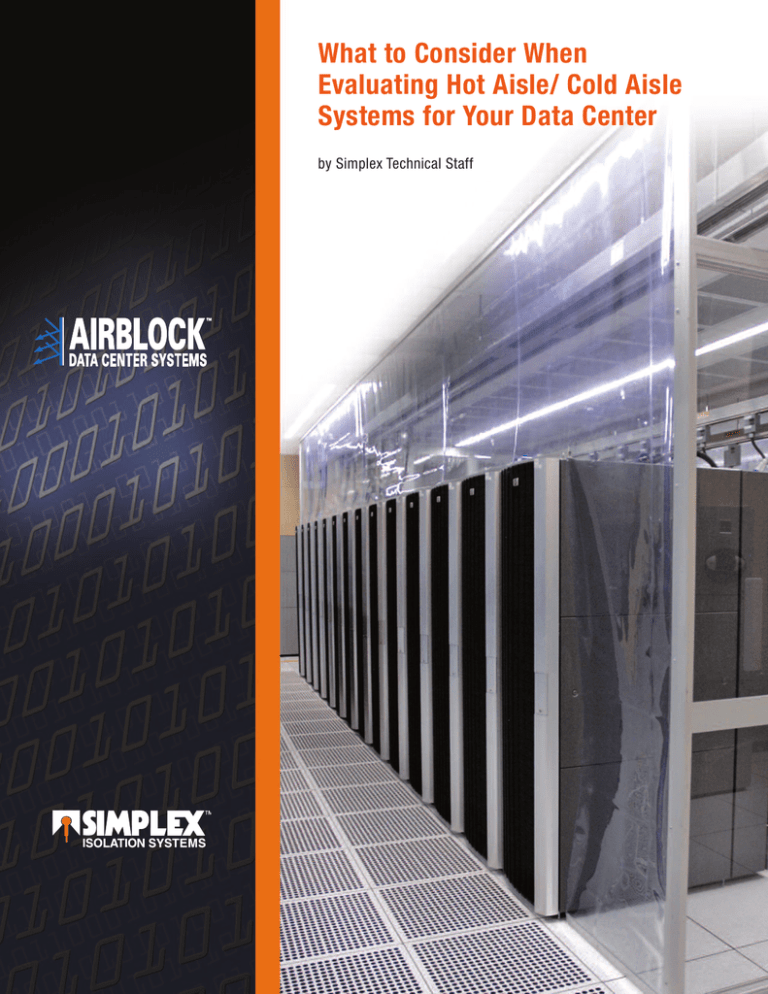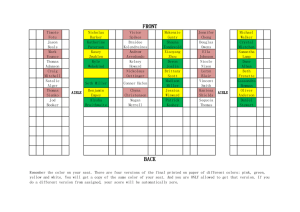What to Consider When Evaluating Hot Aisle/ Cold Aisle Systems for
advertisement

What to Consider When Evaluating Hot Aisle/ Cold Aisle Systems for Your Data Center by Simplex Technical Staff What to Consider When Evaluating Hot Aisle/ Cold Aisle Systems for Your Data Center by Simplex Technical Staff Containment means partitioning off the hot and cold aisles, preventing the air from mixing and compromising the temperatures. Hot aisle and cold aisle positioning in the data center has been standard procedure for decades. But in recent years data center managers, seeking the opportunity for more efficiencies, have added the containment component to this formula. Containment means partitioning off the hot and cold aisles, preventing the air from mixing and compromising the temperatures. This has been a vast improvement in maintaining temperatures in the data center, providing maximum system stability and controlling energy costs. Data center managers report savings of as much as 30%, 40% and even 50% and more. Like any technology, though, results can be maximized by some planning and forethought. What follows are points of advice for data center managers as they make plans for hot aisle and cold aisle containment, and as they plan for data centers in general. 1. More Stable Cooling Means Increased Capacity. Think of your data center as a refrigerator. If you add more cooling, that's like turning up the cold setting on your refrigerator, but not having a door on it. The cold air is quickly diluted. It's an inefficient system. Put a door on the refrigerator, however, and you maintain the integrity of that cold air. Your food stays colder and there is less spoilage. Projects - Solutions - Results 800-854-7951 • www.simplexisolationsystems.com 2 Effective hot aisle/cold aisle containment is like putting a door on the refrigerator. You are maintaining the integrity of the cold air. This means lower, more stable temperatures in the data center. Data center managers can turn up the Among the benefits to hot aisle/cold aisle containment is the thermostat to save energy. The other additional capacity data center managers can get from the same space once temperatures are stabilized and better controlled. benefit is the ability to increase capacity. The need for more computing power and storage is only going to increase, and in some cases it is going to increase drastically. Thanks to advances in chip development, there is increased capacity in computing power and memory, and along with it comes more heat. Hot aisle/cold aisle containment means you can get additional capacity out of the same space. 2. New Construction vs. a Legacy Data Center. New construction data centers are brand new facilities. HVAC systems, the location of CRAC units, the layout of the data center--all of these things can be planned in advance to maximize the benefits of hot aisle and cold aisle containment. But there are thousands of data centers in operation that are already built, and some have been operating for many years. These are called legacy data centers. Legacy centers far outnumber new facilities, and this is where real energy savings can be accomplished. Hot aisle and cold aisle containment can be implemented in legacy data centers, but there are elements which need to be taken into consideration. Much of the infrastructure--specifically HVAC, raised floors, layout and electrical raceways--are already in place. The challenge in installing hot aisle and cold aisle containment in these data centers lies in effectively evaluating what already exists and careful planning to take maximum advantage of these conditions. Projects - Solutions - Results 800-854-7951 • www.simplexisolationsystems.com 3 3. Understand that Data Centers are Complicated. At a chapter meeting of AFCOM, Eugean Hacopians of ARNE Technologies pointed out that data centers today are like living organisms. They are very complicated and many components and factors are in play. "Changing airflow is one thing," said Hacopians, "but changing the behavior of the data center and the people running it--that's the holistic approach that gets more sustainable results." Eugean Hacopians of ARNE Technologies pointed out that data centers today are like living organisms. They are very complicated and many components and factors are in play. The micro processing capacity, the design of the racks, the layout of the room and even the age of the computers are just a few of the countless factors affecting temperatures not only in the room as a whole, but in specific areas. A frequent problem Hacopians cites is the uneven distribution of processor power within a row in a data center. One rack might be loaded up with six or seven kW worth of equipment, and the remaining racks have significantly less. This imbalance can create hot spots within the data center and challenges to cooling. "Look at the cost of running the data center in terms of both the capital expenditure and the cost of operation," said Hacopians. "Computer engineers look at compute cycles, memory usage, input and output, but they don't often look at the power used to run all of this." Hacopians has a suggestion for this: If you want to make your data center manager more cognizant of the operating costs of the data center, change his budget to include paying the energy bill for the data center. He'll start thinking holistically real quick. 4. Get Everyone--Especially Facilities Managers and Your Data Center Manager--on the Same Page. "We've come across a lot of companies where there is not a good relationship between IT and the facilities people," said Jake Stevenson of Enabled Energy. "The larger companies not so much, but especially in companies where there are growing pains, bridging this gap between IT and facilities accomplishes a lot." Eugean Hacopians has much the same opinion. "More often than not a solution is chosen based on a difference of opinion rather than a technology choice," said Hacopians. "Everyone needs to ask if the human factor or the politics of your environment are clouding a reasonable solution." Projects - Solutions - Results 800-854-7951 • www.simplexisolationsystems.com 4 This is the point where senior management needs to get involved, realizing that capital expenditures can be offset by immense savings down the line in energy costs paid from the operating budget, and also the extra productivity (or income, in the case of a colocation facility) from the added capacity. This is everyone's goal. 5. Contact Your Electrical Utility… that is, if they have not already contacted you. There is a good chance that your utility has in place a system of rebates and incentives for companies that take proactive measures to decrease power There is a good chance that your utility has in place a system of rebates and incentives for companies that take proactive usage in their data centers. Some of measures to decrease power usage in their data centers. these rebates are sizable, and are provided as a credit against future bills. Some utilities, however, will provide a lump sum rebate at the conclusion of construction. That money will go a long way in defraying the cost of your data center. NetAPP, a large data storage company in Silicon Valley, installed data center curtains, as well as an array of other energy-saving measures, in one of their data centers in 2007. They received a $140,000 lump sum rebate up front from Pacific Gas & Electric! “Engage your utility before you do anything in your data center in relation to hot aisle/cold aisle containment or other power savings measures,” said Corban Lester, a program development manager for Lockheed Martin. Lester spends most of his time working on data center improvements. “Many utilities offer rebate programs. Each one of them has its own flavor, but the one thing—contacting the utility beforehand—is true with nearly all of them.” The utility might have certain stipulations in place such as approved contractors, approved equipment, and other requirements. Be aware of these requirements as you begin to plan. Becoming aware of them afterwards or during construction can be a headache. There are often specific time windows. These rebates are funded by grants and those moneys may run out, so verify if they are available and the limitations. Corban Lester recommends that you check out the websites for both The Green Grid (www.thegreengrid.org) and the Consortium for Energy Efficiency (www.cee1.org) while you are still in the planning stages. These two nonprofit associations are working to bring data center managers, manufacturers and utilities together in order to promote better communication and standardization in the industry. Projects - Solutions - Results 800-854-7951 • www.simplexisolationsystems.com 5 “There is not always a good transfer of information between all the parties involved in designing, building and approving data centers and the energy savings efforts involved,” said Lester. “The Green Grid and the Consortium for Energy Efficiency are working on improving that situation.” Jon deRidder, president of Enabled Energy, recommends making sure your accountant is familiar with IRS Section 179D. This section, which was created by the Energy Policy Act of 2005, allows for tax deductions for the costs of installing certain energy efficient systems in commercial structures. The deductions are as high as $1.80 per square foot, but there are stipulations. “A lot of the rebates and tax credits available to companies are either not well understood, or just too hard to find,” said deRidder. “Good consultants will assist you in reaping these benefits.” 6. Contact Your Fire Marshal. "You have to know what [fire] jurisdiction you're in and what they accept." Those are the words of Chris Reimer, manager of business development for Facilities Protection Systems, a design/build fire protection contractor in Brea, CA. The firm specializes in data centers. "The fire marshal enforces the local codes/standards and will allow for alternative designs, so he needs to be involved with a project from the beginning," added Reimer. Almost all jurisdictions require that you have a sprinkler system for fire suppression. Sprinkler systems must have eighteen inches of clearance below sprinkler level to insure full dispersal of the water. Curtains or partitions that reach to the ceiling, or enclosures that cover the aisle with ceiling panels, limit the spray pattern and prevent water from reaching a fire. A solution for data center managers using hot aisle/cold aisle containment with curtains, or ceiling panels that cover the aisle, is to use mounting hardware with fusible links that are held together with an alloy designed to melt at Like the electrical utility, you need to involve the Fire Marshal in your a temperature 15 to 20 degrees lower that the temperature region as soon as possible. They at which fire sprinklers activate. When the fire sprinklers may have authorized providers and specific requirements for hot come on, the curtains will have already fallen away, allowing aisle/cold aisle containment. the sprinklers free operating range. An additional measure is to incorporate stainless steel wire lanyards to each mounting bar so that when the fusible links melt and the curtain mount falls away, the hardware will not fall to the floor, but sprinklers will have proper clearance. This allows fire personnel more room to maneuver. Projects - Solutions - Results 800-854-7951 • www.simplexisolationsystems.com 6 An alternative to fuse links that melt at high temperatures are electronic fuse links. Electronic fuse links are typically connected to smoke sensors that, when activated, trip the links in the specific area of your data center where the fire is located. Data center managers planning to use partitions as opposed to curtains and are dealing with a sprinkler-based fire suppression system also need to consider the implications. You may need to budget for sprinkler piping in all the aisles of the data center because designing the partitions to fall way in a fire is not an option. Clean-agent fire-suppression systems use HFC (such as FM -200 TM or ECARO-25TM) or inert gas (such as ProInert™, Argonite™, or Inergen™). These are clean agents dispersed throughout the room to extinguish the fire once smoke has been detected. The individual molecules of these gases are very small. Combined with the velocity at which the gas is dispersed, it will spread throughout the data center quickly. "As long as you are using a clean agent gas that permeates, the gas will be instantaneously homogeneous," added Reimer. "The gas is going to make its way in, up, around and through equipment. It will mix throughout the room and extinguish the fire and allow for anyone remaining within the protected space to breath safely and easily." If you choose to use curtains in your data center, you might all get to demands from the Fire Marshal to source curtain materials that are flame resistant. Simplex recently released an exclusive vinyl material--FlexSim™--that is the first domestically produced clear flexible curtain vinyl to meet the stringent ASTM E-84 Class 1 rating for flame and smoke generation. FlexSim™ also meets or exceeds requirements for NFPA-701 and UL Title 19 for compliance with the California Fire Marshal. Fire suppression in the data center is complicated and involved. It is always good policy to check with the Fire Marshal while still in the planning stages and employ the services of an expert. As Chris Reimer points out, the investment you make initially in fire suppression for your data center is worth it, considering the ramifications of fire damage, downtime and lost information in the event of a mishap later. An additional measure is to incorporate stainless steel wire lanyards to each mounting bar so that when the fusible links melt and the curtain mount falls away, the hardware will not fall to the floor, but sprinklers will still have proper clearance. This allows fire personnel more room to maneuver. Projects - Solutions - Results 800-854-7951 • www.simplexisolationsystems.com 7 7. Realize that Things Change and Base your Purchase of Components on that Reality. You are eventually going to have to Modular designs, like the AirBlock DCT mounting system from Simplex, allow you to design containment that fits your data center--and make changes when you need to. make changes in the data center to accommodate growth or reconfigure the layout. This is why it makes sense to look for mounting hardware for curtains and partitions that are modular in design, allowing you to make quick changes. 8. Pay Attention to the Location of A/C or CRAC units. Best practice is to get all the air running in one direction. Optimum placement of the cabinets is perpendicular to CRAC units. This affords a more direct path for hot air to run back to CRAC units. If the cabinets are parallel to the CRAC units it means hot air has to go around or through the racks, which takes more energy to pull it and could cause hot spots throughout the room. Generally best practices call for positioning the CRAC unit directly at the end of the hot aisle. This gives the hot air a straight path back to the unit. You can lose efficiency if you set it up any other way. 9. Your Data Center Does Not have to be Homogenous. In the magazines and on the Internet we see photos of data centers with rows and rows of racks, all the same brand, shape and size. We wish it were that simple. For legacy data centers in particular, as you have expanded and reconfigured the data center, combined facilities, added additional processing power and removed damaged Make sure AC and CRAC units in the data center are racks, your rack census may consist of three of positioned the move through the racks as efficiently as possible. four different racks and countless sizes. How is one hot aisle and cold aisle containment system going to accommodate all this variation? AirBlock data center curtains from Simplex are designed especially for such applications. Versatile mounting systems can be reconfigured to match your changing needs. You can even accommodate offset rows. Curtains of various sizes and lengths are used for racks of varying height, and easily attached expandable filler panels are used to cover gaps for racks that have been temporarily moved. Projects - Solutions - Results 800-854-7951 • www.simplexisolationsystems.com 8 10. Keep Ergonomics in Mind. You will install doors and other features to make the data center easier to work in, and to move racks and other items in and out. Think about doors--sliding doors, hinged doors, strip curtains. Think about which way you want the door to open. Look for issues of clearance and traffic. The more sophisticated data center containment systems give you a choice of door configurations that best fit the traffic patterns and other needs of your data center. 11. Isolating the Aisle Means Sealing Everything. Data center managers can spend a lot of energy, time and money making sure they have sealed off the wide open walls in a data center, but they will overlook the small area above a rack or wiring loom, or the hole in a Plexiglas wall through which wires and cables pass. But air is like fluid in a data center. It will take the path Good containment design means that hot air and cold are prevented from mixing in all locations, especially over the tops of the racks. of least resistance and you will experience serious leaks in these overlooked areas as cool air comes rushing through to mix with the warm air. Specially designed short curtains and brush seals can be used to close off these areas. Jake Stevenson at Enable Energy also points out the gaps that exist when racks are moved out of a data center, even temporarily, or when racks of a different type or brand are placed next to each other. Even racks in which one or more of the U’s are empty offer a significant enough gap for hot air to travel through the rack back into the cold air aisle. Expandable filler panels like those from Simplex, used to fill the gap between racks when one is removed, guard against this, as do interior rack blanking panels used to fill in a partially empty rack. Projects - Solutions - Results 800-854-7951 • www.simplexisolationsystems.com 9 12. Hot Aisle Containment versus Cold Aisle Containment. There is a huge discussion in the industry about whether it makes more sense to isolate the hot aisle or the cold aisle. Different data center experts advocate different theories. The reality is your decision on this question, especially in a legacy data center, is largely decided by your existing infrastructure. Where is the cold air coming from? Where does the warm air have to go in order to be exhausted from the data center or rerouted back into the HVAC or CRAC units? Certain factors will dictate whether you isolate the hot aisle for the cold aisle. Every case is site specific. 13. Consult an Expert Every Step of the Way. Remember the words of Eugean Hacopians: Data centers are very complicated and many components and factors come into play. Every element figures into how your data center is going to react not only to hot aisle/cold aisle containment, but increases in processing capacity, positioning of racks and everything else. The money you spend on a knowledgeable consultant will pay off in lower energy bills and increased stability later on. Founded in 1979, Simplex Isolation Systems designs and manufactures custom cleanrooms that are modular and expandable, as well as a number of products for use in process isolation and contamination control. Simplex is also a prominent name in the data center industry for hot aisle and cold aisle isolation. Their innovative products and materials offer significant advantages. Simplex has worked with some of the leading names in data centers in the U.S., including eBay, AT&T, Walt Disney Studios, Caltech, Oracle and many more. 14500 Miller Ave. • Fontana, CA 92336 Toll-free: 800-854-7951 • Fax: 909-429-0217 www.simplexisolationsystems.com info@simplexstripdoors.com 10




